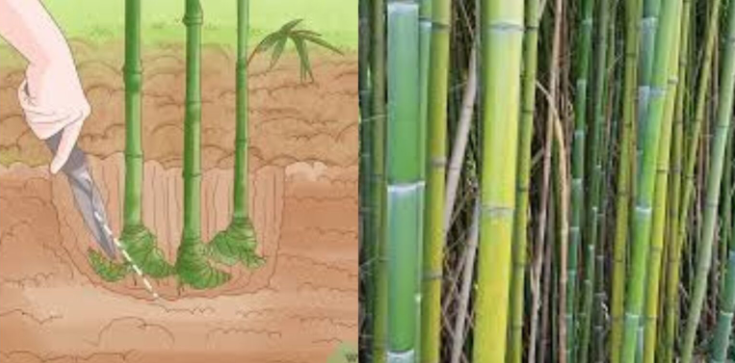Bamboo is a plant that evokes mixed feelings among gardeners. On one hand, its elegant appearance and fast growth can enhance the beauty of a garden; on the other hand, it can quickly become invasive, spreading aggressively and taking over valuable garden space. If you find yourself struggling to control bamboo in your landscape, this article will guide you through six effective and permanent methods to eradicate it.
Understanding Bamboo Growth
Before delving into the methods for killing bamboo, it’s essential to understand how it grows. Bamboo can be classified into two main types: clumping bamboo and running bamboo.
- Clumping Bamboo: This type grows in tight clusters and is less invasive. It tends to expand slowly and is often easier to manage.
- Running Bamboo: This variety spreads through underground rhizomes, making it aggressive and difficult to control. It can quickly take over large areas, often outcompeting other plants.
The methods you choose for elimination may vary based on the type of bamboo you’re dealing with, but the following techniques are generally effective for both types.
Method 1: Cutting
Step-by-Step Instructions
- Assess the Area: Identify the bamboo’s growth area and check for rhizomes spreading underground.
- Cut the Stalks: Use pruning shears or a saw to cut the bamboo stalks as close to the ground as possible. Make sure to wear gloves and protective eyewear to avoid injury.
- Timing: The best time to cut bamboo is in late summer or early fall when the plant is actively growing. This maximizes the effectiveness of subsequent methods.
Effectiveness
Cutting is a non-invasive method that can temporarily reduce the visibility of bamboo. However, it does not kill the plant and should be combined with other techniques for lasting results.
Method 2: Digging Up Roots
Step-by-Step Instructions
- Prepare the Area: Clear away any surrounding plants to access the bamboo root system easily.
- Digging: Use a shovel or spade to dig around the bamboo clumps. Aim to remove as much of the root system as possible, including rhizomes that may have spread underground.
- Remove the Roots: Carefully lift the bamboo clumps out of the ground and inspect the roots. Any remaining rhizomes can regenerate the plant.
- Dispose of Properly: Place the removed bamboo and roots in a sealed plastic bag to prevent them from re-rooting in your compost pile or garden.
Effectiveness
Digging up the roots is one of the most effective methods for permanently eliminating bamboo, especially running varieties. However, this technique requires a significant amount of labor and can be challenging, particularly if the bamboo has established deep roots.
Method 3: Smothering
Step-by-Step Instructions
- Prepare the Site: Cut the bamboo down to ground level.
- Cover the Area: Use heavy tarps, cardboard, or mulch to cover the cut bamboo completely. Ensure that the covering is thick enough to block out sunlight.
- Weight It Down: Secure the covering with stones or soil to prevent it from blowing away and to ensure it remains in place.
- Duration: Leave the smothering material in place for several months, ideally during the growing season, to weaken and eventually kill the bamboo.
Effectiveness
Smothering is a simple and environmentally friendly method that works well when combined with cutting. The lack of sunlight will inhibit the growth of the bamboo, leading to its demise over time.
Method 4: Herbicide Application
Step-by-Step Instructions
- Choose the Right Herbicide: Select a systemic herbicide containing glyphosate, which is effective for killing bamboo.
- Cut the Stalks: As in the cutting method, trim the bamboo down to ground level.
- Apply the Herbicide: Use a paintbrush or spray bottle to apply the herbicide directly to the cut stems or leaves. Be cautious not to spray surrounding plants to avoid damage.
- Follow Directions: Always follow the manufacturer’s instructions for safety precautions and application rates.
Effectiveness
Herbicides can be highly effective for killing bamboo, particularly when applied at the right time (late summer or early fall). However, it’s important to consider the environmental impact of chemicals and use them responsibly.
Method 5: Salt Treatment
Step-by-Step Instructions
- Prepare Salt Solution: Mix table salt with water to create a concentrated saltwater solution. A ratio of 3 parts salt to 1 part water is effective.
- Apply to Roots: Pour the salt solution directly onto the exposed roots or into the holes where you have cut the bamboo.
- Monitor Moisture Levels: Salt can dehydrate plants, so ensure that it doesn’t affect nearby plants by applying it carefully.
Effectiveness
Salt can effectively kill bamboo, but it should be used with caution as it can harm the soil and other plants. This method is most effective for small patches of bamboo and should be applied judiciously.
Method 6: Vinegar Spray
Step-by-Step Instructions
- Choose the Right Vinegar: Use concentrated vinegar with a 20% acetic acid concentration for better results.
- Spray the Bamboo: Apply the vinegar directly to the leaves and stems of the bamboo during a sunny day. The acidity will desiccate the plant.
- Reapply: You may need to reapply the vinegar several times to ensure effective coverage and penetration.
Effectiveness
Vinegar is a natural herbicide that can effectively kill bamboo, especially when used in hot, sunny conditions. However, like salt, it can also affect nearby plants, so be careful when applying.
Conclusion
Killing bamboo may require persistence and multiple methods, especially if it has become well-established in your garden. By combining these six effective strategies—cutting, digging, smothering, herbicide application, salt treatment, and vinegar spray—you can successfully eradicate bamboo and reclaim your outdoor space.
While some methods may require more effort and time than others, it’s essential to approach bamboo removal with a comprehensive plan. By understanding the growth habits of bamboo and applying the right techniques, you can enjoy a bamboo-free garden and prevent future invasions.
